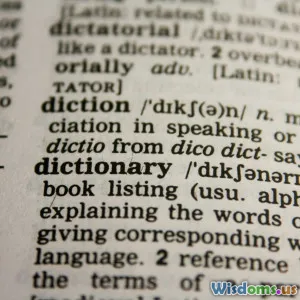
Is Syntactic Ambiguity Hiding In Your Favorite Novels
7 min read Explore how syntactic ambiguity shapes your favorite novels, driving plot, character, and deeper meanings through deliberate, playful uses of language. (0 Reviews)
Is Syntactic Ambiguity Hiding In Your Favorite Novels?
Introduction: Under the Surface of Stories
Have you ever re-read a line from your favorite book and suddenly realized it could mean something entirely different—not just in what it says, but in how it can be read? The world of literature is filled with layered meanings, misinterpretations, and double entendres, many of which hinge not just on vocabulary, but on structure. This phenomenon, known as syntactic ambiguity, operates quietly yet powerfully, shaping everything from the smallest comedic misunderstanding to the most life-altering dramatic revelation. It’s easy to miss concealed ambiguities on a first read—but what if unlocking them could change the way you experience novels forever?
In this article, we’ll peel back the layers of syntactic ambiguity, uncovering its presence in classic and contemporary novels alike. We’ll visit bestsellers, analyze famous lines, and see both intentional and accidental ambiguity at work, illustrating how this trick of language inspires laughter, heartbreak, suspense, and profound interpretation. Prepare to rediscover beloved books with new insight into the carefully constructed, occasionally confusing structures that make literature come alive.
What Is Syntactic Ambiguity? Understanding the Linguistic Chameleon
Before we dive into textual treasure hunts, let's clarify definitions. Syntactic ambiguity, also called structural ambiguity, arises when a sentence can be parsed in more than one way due to its structure, allowing for multiple interpretations. It differs from lexical ambiguity, where a single word has more than one meaning.
A Simple Example
Consider the sentence:
"I saw the man with the telescope."
Did I use a telescope to see the man, or did the man have the telescope? This single sentence opens up two possibilities—both equally plausible until context guides the reader. Syntactic ambiguity like this creates openings for creativity or confusion in literature, sometimes deliberately, sometimes by accident.
Syntactic Ambiguity in Classic Novels: Accidents and Artistry
From Shakespeare to Austen, classic novelists have often played with (or sometimes tripped over) syntactic ambiguity. Let’s explore how it shapes classic works.
Shakespeare's Double Bindings
William Shakespeare, master of wordplay, famously employed ambiguity for dramatic and comedic effect. One of his most quoted ambiguous lines occurs in Hamlet:
“Though this be madness, yet there is method in’t.”
The ambiguity here builds not just through vocabulary but in the flexible syntax—does Hamlet enact method through madness, or is method discerned within the display of madness? Nuanced structural choices draw us into Hamlet’s mental labyrinth.
Jane Austen’s Wit and Misunderstandings
No discussion of ambiguity is complete without Jane Austen. Her social comedies, such as Pride and Prejudice, thrive on the precarious interplay between speech and intention:
“Elizabeth, as they drove along, watched for the first appearance of Pemberley Woods with some perturbation; and when at length they turned in at the lodge, her spirits were in a high flutter.”
Is Elizabeth’s “high flutter” anticipatory joy, anxiety, or both simultaneously? Austen's careful syntactic construction invites varied readings, letting character and reader decipher meaning in concert.
When Meaning Turns on a Comma: Ambiguity and Punctuation
Writers can turn the gears of ambiguity with punctuation alone. Consider:
“Let’s eat, Grandma!” vs. “Let’s eat Grandma!”
Sometimes, the only thing standing between hospitality and horror is a comma. Writers such as Charles Dickens and Oscar Wilde knew well the power—and peril—of this tool. In Great Expectations, Charles Dickens plays with narrative ambiguity:
“My friend Mr. Jaggers was always emphatic and clear on these points, and I was always rather afraid of him.”
Does “these points” modify “my friend Mr. Jaggers,” “emphatic and clear,” or both? Minor ambiguities can lend texture or invite debate, and in Dickensian dialogue, different punctuation could shift entire power dynamics.
Syntactic Ambiguity in Modern Literature: Subtle Layers
Modern authors are as susceptible—and often more deliberate—in their use of ambiguous constructions.
J.K. Rowling’s Playful Prompts
In the Harry Potter series, J.K. Rowling occasionally uses ambiguous structure to sow seeds of mystery or humor:
“Harry saw Ron and Hermione walking through the library door.”
Did Harry see Ron, and also Hermione who was walking through the library door, or did he see the pair walking together? It's subtle, but such phrasing can prompt readers’ imaginations and misdirect their expectations—especially in whodunit-style chapters.
Cormac McCarthy’s Emotional Mysteries
Known for his distinctive, sometimes sparse, sometimes sprawling sentences, Cormac McCarthy crafts ambiguity to heighten emotional stakes.
“She told him that she loved him—that she would wait, that everything would work out.”
Are all these claims coming from the character, or are some the narrator’s inferences? The ambiguity broadens interpretive scope, leaving room for doubt, longing, and pathos.
The Case of George Saunders
Saunders, lauded for the experimental use of language in short fiction, often crafts sentences playing on structure for both comic effect and layered meaning:
“He told my mother he loved her and that he would respect her wishes.”
Does “and that he would respect her wishes” apply only to the mother, or to
Rate the Post
User Reviews
Popular Posts















